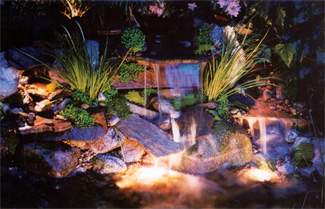
A combination of low voltage underwater lighting and above ground lighting can enhance your waterfall nightscape. All the lighting components needed are usually purchased by Schevers at Home Depot.

Choosing the kind of lighting features further enhances the pond and is important for setting a mood or a tone. Low voltage water feature lighting comes in all kinds of packages that can change colors, be pre-set to a revolving pattern, or just spotlight various plants and rock features.
“I find so much peace being in this business,” says Jamie, “and it’s even better to be able bring other people a feeling of peace and serenity in today’s stressful world.”
